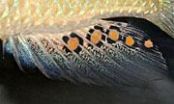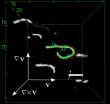(Press-News.org) The evolution of new traits with novel functions has always posed a challenge to evolutionary biology. Studying the color markings of cichlid fish, Swiss scientists were now able to show what triggered these evolutionary innovations, namely: a mobile genetic element in the regulatory region of a color gene. Their results have been published in the latest issue of the renowned scientific journal Nature Communications.
Biological evolution is in general based on the progressive adaption of traits through natural or sexual selection. However, ever so often, complex traits with completely new functions arise such as insect wings, feathers or the placenta. The evolution of such evolutionary innovations is often hard to explain relying solely on the model of progressive modification of already existing traits. Furthermore, it is largely unknown which genome modifications actually lead to evolutionary innovations.
A team of Basel researchers jointly lead by Prof. Walter Salzburger from the Department of Zoology and Prof. Markus Affolter from the Biozentrum at the University of Basel now clarified the genetic and developmental origins of an evolutionary innovation in African cichlids. The males of over 1,500 species feature conspicuous color markings on their anal fins – so called egg-spots – that play a central role in the mating behavior of these mouth-breeding fish. Immediately upon spawning, the female gathers up her eggs into the mouth before fertilization. The male then presents his egg-spots to which the female responds by snatching and bringing her mouth close to the male's genital opening – only now are the eggs being fertilized inside the female's mouth.
"Jumping genes"
The Basel biologists were able to show that the evolution of egg-spots is linked to the insertion of a mobile genetic element – a "jumping gene" – in the regulatory region of a newly identified pigmentation gene. These mobile elements are short DNA strings that are able to change their position within the genome and can influence the regulation of other genes.
In the case of the cichlid's egg-spots, the presence of the "jumping gene" upstream of a pigmentation gene with the name fhl2b leads to an alteration in gene expression in pigmentation cells and therefore to the development of the characteristic egg-spot pattern on the male cichlids' anal fin. The scientists came to this conclusion after having induced the cichlids' genome segment containing the mobile element into zebrafish embryos. In fact, they were able to locate the according expression in a specific group of pigmentation cells. "These results illustrate once more the importance of changes in gene expression in evolution", comments Prof. Walter Salzburger the findings.
INFORMATION:
Original source
M. Emilia Santos, Ingo Braasch, Nicolas Boileau, Britta S. Meyer, Loic Sauteur, Astrid Böhne, Heinz-Georg Belting, Markus Affolter & Walter Salzburger
The evolution of cichlid fish egg-spots is linked with a cis-regulatory change
Nature Communications 5:5149 (10.1038/ncomms6149)
David Brawand et al.
The genomic substrate for adaptive radiation in African cichlid fish
Nature 513: 375-381.
The cichlids' egg-spots: How evolution creates new characteristics
2014-10-09
ELSE PRESS RELEASES FROM THIS DATE:
Understanding the bushmeat market: Why do people risk infection from bat meat?
2014-10-09
Ebola, as with many emerging infections, is likely to have arisen due to man's interaction with wild animals – most likely the practice of hunting and eating wild meat known as 'bushmeat'. A team of researchers led by the University of Cambridge and the Zoological Society of London (ZSL) has surveyed almost six hundred people across southern Ghana to find out what drives consumption of bat bushmeat – and how people perceive the risks associated with the practice.
The Straw-Coloured Fruit Bat, Eidolon helvum, is widely hunted and eaten in Ghana, but carries ...
A cost-effective and energy-efficient approach to carbon capture
2014-10-09
Carbon capture is a process by which waste carbon dioxide (CO2) released by factories and power plants is collected and stored away, in order to reduce global carbon emissions. There are two major ways of carbon capture today, one using powder-like solid materials which "stick" to CO2, and one using liquids that absorb it. Despite their potential environmental and energy benefits, current carbon capture strategies are prohibitive because of engineering demands, cost and overall energy-efficiency. Collaborating scientists from EPFL, UC Berkley and Beijing have combined carbon-capturing ...
Of bio-hairpins and polymer-spaghetti
2014-10-09
Jülich, Germany, 9 October 2014 – When a basically sturdy material becomes soft and spongy, one usually suspects that it has been damaged in some way. But this is not always the case, especially when it comes to complex fluids and biological cells. By looking at the microscopic building blocks – known as "filaments" – of biopolymer networks, researchers from Forschungszentrum Jülich, Germany and the FOM Institute AMOLF in the Netherlands, revealed that such materials soften by undergoing a transition from an entangled spaghetti of filaments to ...
Human health, wealth require expanded marine science, experts say
2014-10-09
Some 340 European scientists, policy-makers and other experts representing 143 organizations from 31 countries spoke with one voice today, publishing a common vision of today's most pressing marine-related health and economic threats and opportunities.
In a declaration concluding a three day meeting in Rome, EurOcean 2014 participants also released an agreed, five-year roadmap to achieve expanded, more integrated and effective policy-oriented ocean scrutiny.
EurOcean 2014 was convened by the Italian Presidency of the Council of the European Union, the European Marine ...
Why men are the weaker sex when it comes to bone health
2014-10-09
Nyon, Switzerland (October 9, 2014) – Alarming new data published today by the International Osteoporosis Foundation (IOF), shows that one-third of all hip fractures worldwide occur in men, with mortality rates as high as 37% in the first year following fracture. This makes men twice as likely as women to die after a hip fracture. Osteoporosis experts warn that as men often remain undiagnosed and untreated, millions are left vulnerable to early death and disability, irrespective of fracture type.
The report entitled 'Osteoporosis in men: why change needs to happen' ...
Circulating tumor cells provide genomic snapshot of breast cancer
2014-10-09
(PHILADELPHIA) -- The genetic fingerprint of a metastatic cancer is constantly changing, which means that the therapy that may have stopped a patient's cancer growth today, won't necessarily work tomorrow. Although doctors can continue to biopsy the cancer during the course of the treatment and send samples for genomic analysis, not all patients can receive repeat biopsies. Taking biopsies from metastatic cancer patients is an invasive procedure that it is frequently impossible due to the lack of accessible lesions. Research published October 10th in the journal Breast ...
Timing of epidural is up to the mother
2014-10-09
When a woman is in labour, the appropriate time to give an epidural during childbirth is when she asks for it, a new study suggests. Published in The Cochrane Library, the systematic review compared early and late epidurals during labour and found that they had very similar effects.
An epidural is a pain relieving local anaesthetic that is given as an injection into the spine. It is commonly offered to women in labour who request pain relief and is effective in reducing pain. However, previous studies have suggested that the timing of an epidural can prolong the duration ...
Women who eat fried food regularly before conceiving are at increased risk of developing gestational diabetes during pregnancy
2014-10-09
New research published in Diabetologia (the journal of the European Association for the Study of Diabetes) shows that women who eat fried food regularly before conceiving are at increased risk of developing gestational diabetes during pregnancy. The research is led by Drs Cuilin Zhang and Wei Bao, Eunice Kennedy Shriver National Institute of Child Health and Human Development (NICHD, part of the US National Institutes of Health) Rockville, MD, USA, and colleagues.
Gestational diabetes (GDM) is a complication that can arise during pregnancy, and is characterised by abnormally ...
Online intervention tool for physician trainees may improve care of substance users
2014-10-09
Online learning interventions and small group debriefings can improve medical residents' attitudes and communication skills toward patients with substance use disorders, and may result in improved care for these patients, according to a new study from the Perelman School of Medicine at the University of Pennsylvania and Drexel University College of Medicine published online in Academic Medicine.
The study used a novel internet-based learning module designed to improve the communication skills of primary care physicians during screenings and brief counseling sessions with ...
New gene therapy for 'bubble boy' disease appears effective, safe, study in NEJM reports
2014-10-09
BOSTON (October 9, 2014) –A new form of gene therapy for boys with X-linked severe combined immunodeficiency syndrome (SCID-X1), a life-threatening condition also known as "bubble boy" disease, appears to be both effective and safe, according to a collaborative research team from Dana-Farber/Boston Children's Cancer and Blood Disorders Center and other institutions conducting an international clinical trial. Early data suggest that the therapy may avoid the late-developing leukemia seen in a quarter of SCID-X1 patients in pioneering gene therapy trials in Europe more ...



